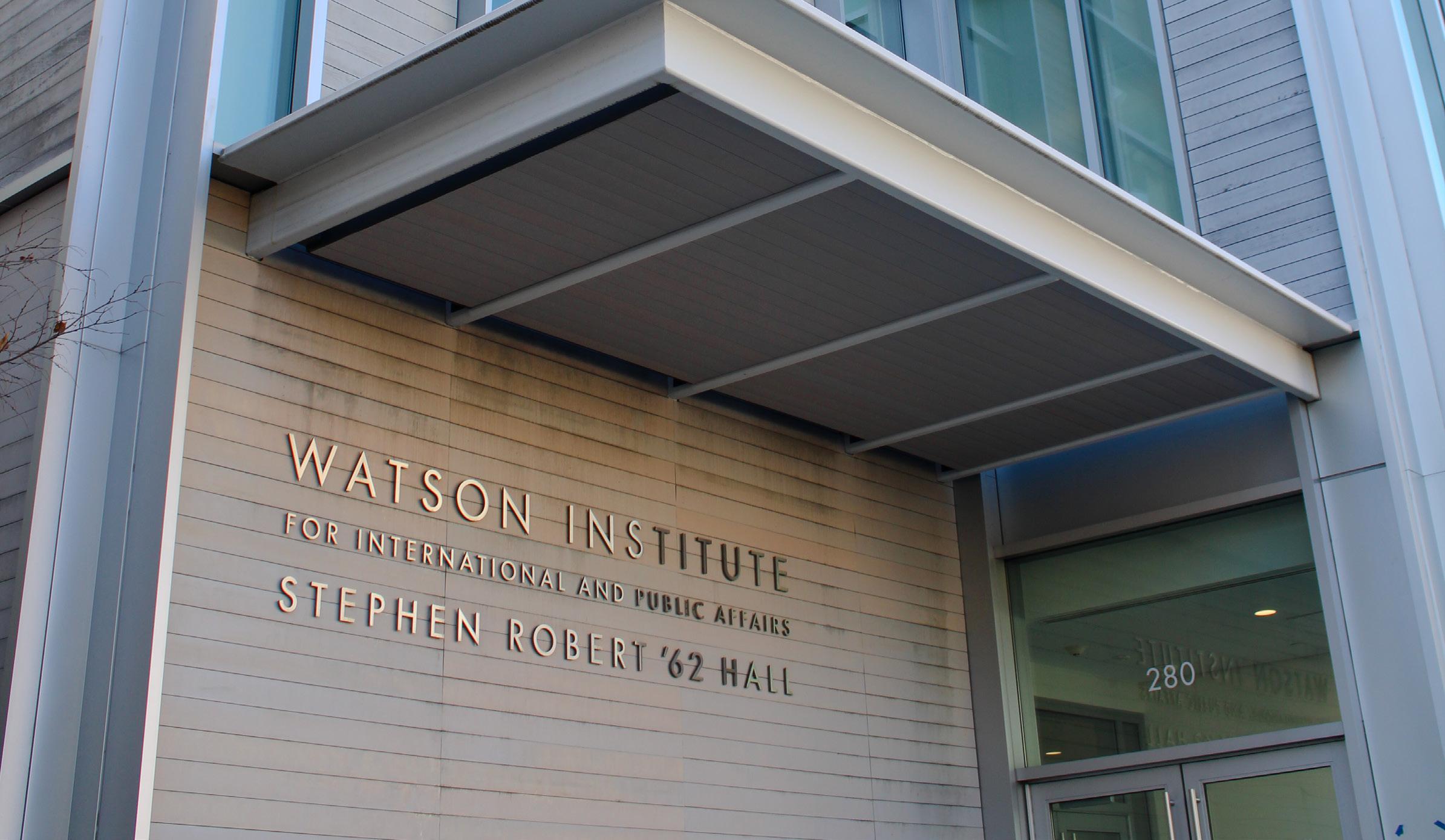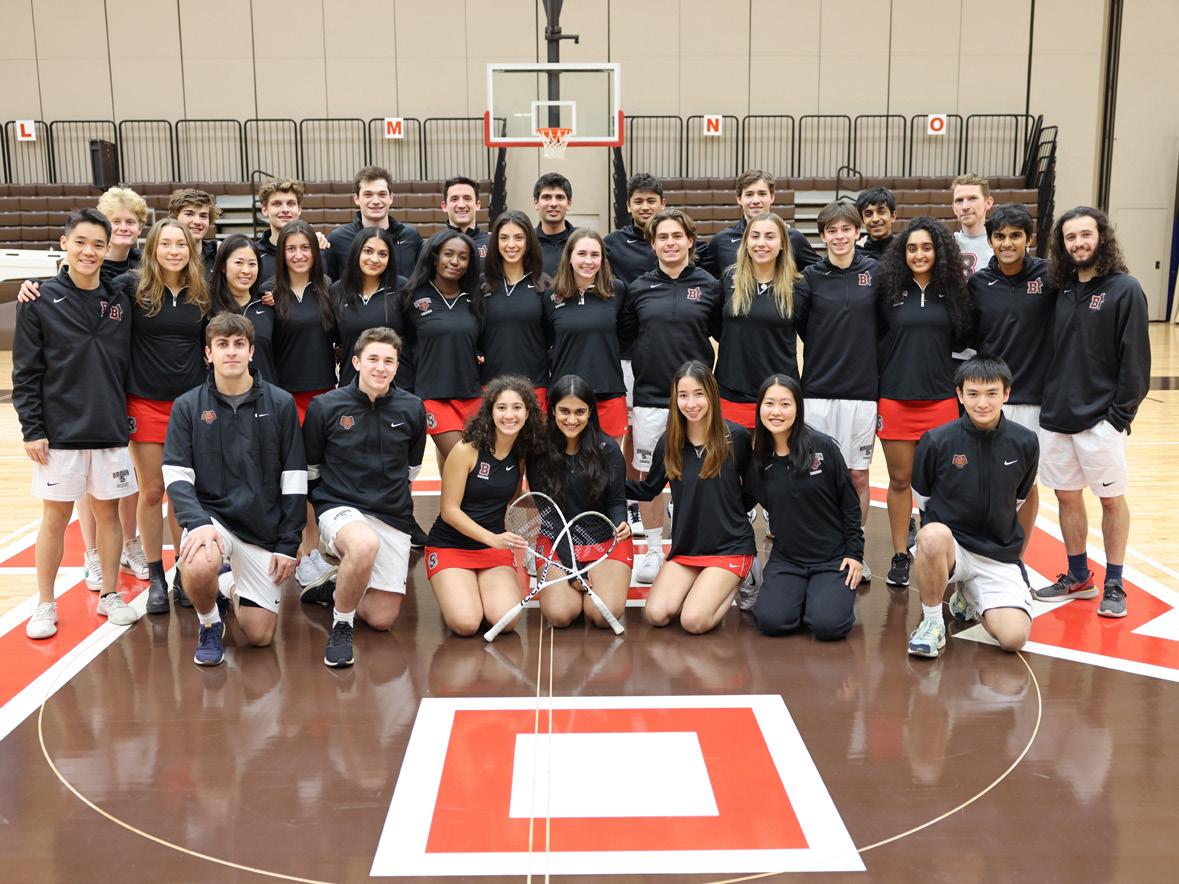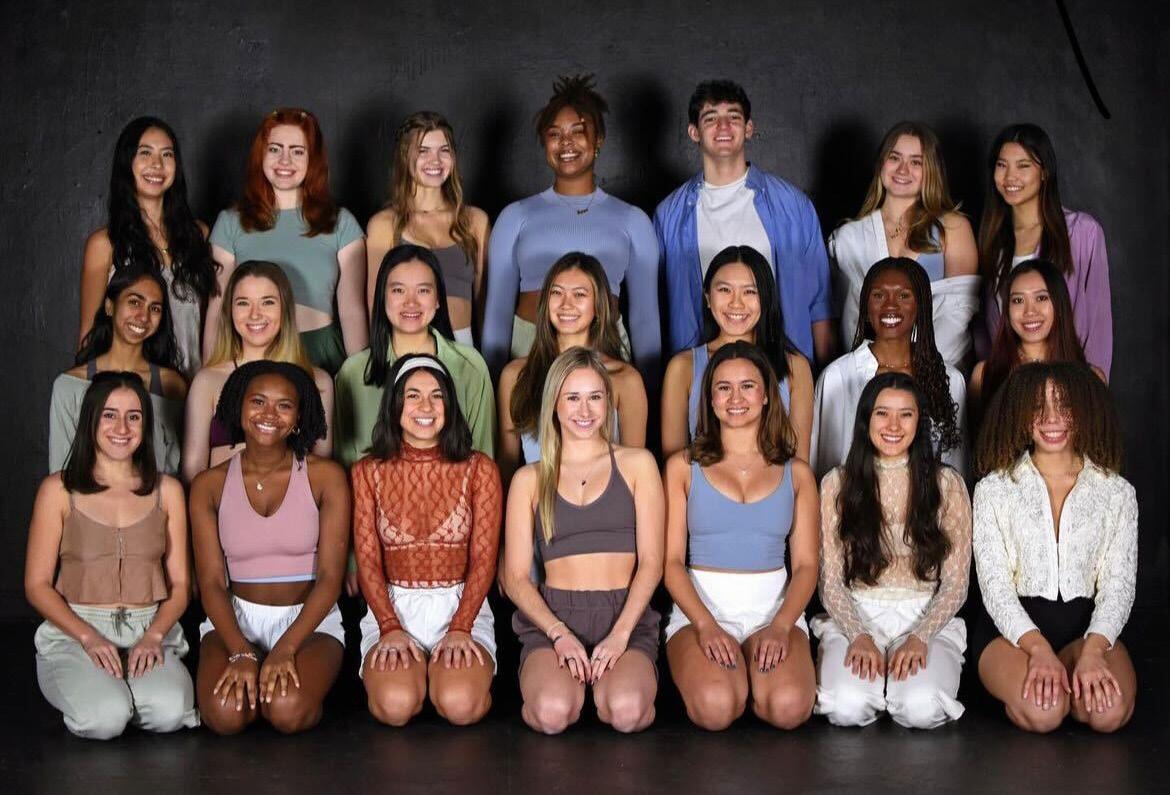
9 minute read
Men’s hockey ties 2-2 against Colgate in final game of season
Team honors 10 seniors in their last game at Meehan Auditorium
Saturday
Advertisement
BY AUSTIN XIANG STAFF WRITER
The men’s hockey team (9-17-3, 5-14-3 ECAC) tied against Colgate (14-15-5, 11-8-3 ECAC) in a 2-2 battle Saturday night, with Colgate winning the shootout and securing the extra point in the Eastern College Athletic Conference standings. The Bears were coming off a 5-0 loss the previous night against Cornell, which is ranked No. 13 in the country.
The team “did a good job in terms of responding (to) what was an awful night for us,” said Head Coach Brendan Whittet ’94. “We gave ourselves an opportunity to win.”
Brown and Colgate last went head to head in November, when the Colgate Raiders won 3-2 in a close overtime battle. Coming into this game, Whittet said that he knew the Bears were facing a “skilled” team.
“They have an outstanding power play. They have one of the best forwards in the league in (Alex) Young,” Whittet said, adding that the Bears’ defense improved dramatically following the match with Cornell.
Around 10 minutes into the first period, Bears defenseman Brett Bliss ’25 was sent to the box for a tripping penalty. Less than two minutes later, a penalty for interference on James Crossman ’23 gave Colgate a brief 5-on-3, but Bruno survived both power plays and the game remained scoreless.
The Bears got on the board in the second period when Ryan Bottrill ’26 found an open Jordan Tonelli ’24 in front of the opposing goal. Tonelli fired a shot past three Colgate defenders and the left side of the goaltender.
It was “just a really good job by my linemates,” Tonelli said of his goal, adding that Nathan Plessis ’23 “won a battle, got it to Ryan Bottrill, and he just found me in the slot, and I got lucky it went in.”
Around five minutes later, the Bears took a two-point lead, with Jonny Rus- sell ’23 scoring his sixth goal of the year, assisted by Ryan Shostak ’26 and captain Luke Krys ’23.
“The puck was kind of bouncing around the boards, so I pounced on it,” Russell said. “We had a threeon-one and (I passed it) to (Shostak). (Shostak) gave me a nice pass back and I managed to squeak it in.”
But the two-point lead was shortlived. An unsportsmanlike conduct call on Tonelli gave the Raiders a power play, allowing Colgate’s Ethan Manderville to score by deflecting a shot from teammate Nick Anderson.
Not long after, Colgate’s Matt Verboon redirected an initial shot from the left point, sneaking it by the right side of Bears goalie Mathieu Caron ’25 and tying the game at two points apiece.
“We got a little bit deflated after their two back-to-back goals, but we came into (the) third period with a ton of confidence,” Krys said.
A back-and-forth third period went scoreless and the game headed to overtime, which saw a hooking penalty on Young just 28 seconds in. But
Raiders goalie Carter Gylander blocked three power play shots from Brown to keep the game tied. Colgate had an opportunity to end the game on a last-second shot in transition from forward Ross Mitton, who skated past all of the Bears’ defenders, but Caron trapped the puck under his leg pads as time expired.
“I will say (Caron) is the best goalie in the league,” Whittet said. Caron returned on Friday against Cornell after missing the last six games. “He’s our MVP. He gives us an opportunity to win every time he’s in.”
In the shootout, Brown sent Tonelli, Samuli Niinisaari ’23 and Bradley Cocca ’23 to take the team’s shots. Tonelli and Niinisaari failed to score against Gylander. On the other side of the rink, Caron saved a shot from Manderville.
Verboon took the fourth shot of the shootout. His attempt was originally ruled unsuccessful, as it appeared to hit the bottom of the crossbar and deflect out. But after a replay review, the call was overturned, as the referees said the shot hit the net instead of the crossbar.
Cocca failed to match Verboon’s shot and Colgate won the shootout, taking two out of the game’s three points in the ECAC standings.
“We wish we would have come out with the dub in the shootout or possibly even earlier, but with a lot of seniors’ last time playing at Meehan it’s a little emotional,” Tonelli said.
Saturday marked the team’s senior night. The Bears celebrated their 10 seniors after the game in front of the home crowd.
The team’s seniors “are good hockey players, but they’re even better guys,” Whittet said. “They’re people that I like to be around and people that are just a team first and do everything in their power to help Brown when we step on the ice — when we put on the uniform to perform.”
Brown will go on the road for their first-round playoff game Saturday against Clarkson (15-15-4, 9-10-3 ECAC) in Potsdam, New York.
“We’ll definitely game plan specifically for Clarkson,” Russell said. “If we do what we need to do, we can beat anyone.” tive bracket and they did not just defeat the competition — they dominated it.
The men’s team swept both Boston University and the University of Chicago 9-0 in the opening rounds to advance to the finals, where they beat Georgetown 8-1. The team dropped just eight individual games — and only lost one match — while winning 79 over the course of the weekend.
On the women’s side, the team swept Colgate in the first round — going a perfect 27-0 in their individual games in the process — before defeat- ing Northeastern 8-1 and Boston College 7-2 to earn their championship.
The team finished the tournament 73-12 in individual games.
“We were expected to win,” Dowling said. “And we did.”
Dowling noted that Brown’s participation “takes away a chance from other club teams to be able to win club nationals” because the University’s team includes recruited athletes.
“It’s not fun for anybody to have that big of a skill gap,” Roshkoff said, adding that several players from the opposing teams said that Brown’s participation in the championships was “ridiculous” and that they were “trying to push to get” Brown out of the tournament.
But “at the end of the day, this is a national tournament,” Roshkoff added. “I’m gonna play at the level I would have played (at) if it was varsity.”
Several players from the teams, including Amin, Dowling and Roshkoff, will be returning to Philadelphia next weekend for the national doubles championships and individual championships. These tournaments will give them an opportunity to face off against varsity-level competition.
Among the participating players, Rachel Mashek ’24 and Roshkoff will attempt to defend the pair’s mixed doubles title from last spring, while Mashek and Danielle Benstock ’23 look to avenge their loss in the previous year’s doubles championship game.
“We had really good results last year,” Dowling said. “So we’re excited to hopefully do that again and continue to try to make a statement about our ability to compete with varsity teams.”
While their status may have changed, members said the teams’ dedication to excellence in the sport
— and the strong bonds of camaraderie between them — has remained consistent, serving as a key factor in their continued success.
“The level of commitment that is required is much greater than most other club teams,” Dowling said. “We practice every day of the week — a lot of early morning practices, a lot of traveling (and) we had a ton of matches this season.”
“We stayed strong and stayed together — and it’s paid off, as we’ve seen this year,” Amin said. “Even with the bumps along the road, we’ve gotten through it together.”
Affirmative action may be off the table — but legacy admissions are not the answer
With the Supreme Court poised to strike down race-conscious admissions, Brown is considering a number of alternative strategies to uphold student body diversity without affirmative action. Associate Provost for Enrollment Logan Powell, at a recent panel, suggested that the University rely on legacy admissions — the practice of giving the relatives of alumni an advantage in admissions — as part of its response. But this plan would fail to ensure the campus diversity Brown seeks to uphold and perpetuate socioeconomic inequities on campus. Further reliance on legacy admissions should have no place in Brown’s overall response to the end of affirmative action.
Powell argued that Brown has admitted “increasingly diverse classes of students, which means that their children are increasingly diverse.” The argument here seems to be that, by increasing legacy admissions, the University could generate a trickle-down form of diversity, where enrolling the children of alumni allows student demographics of coming generations to reflect previous ones.
Dubbed “affirmative action for whites” and “affirmative action for the rich,” legacy admissions have historically perpetuated socioeconomic disparities. First instituted in response to an increase in Jewish and Catholic applicants to top American universities, legacy admissions have since been giving a significant leg up to students who, by definition, have highly-educated parents, likely with high-paying jobs.
Brown students have long opposed legacy admissions at Brown, through campaigns like #LeaveYourLegacy and groups like Students for Educational Equity. Student group leaders have described legacy admissions as reinforcing “a cycle of inequity.” It is ironic that Brown would now offer the policy as part of a solution to the exclusivity and inaccessibility of higher education when Brown students have spoken against the practice for contributing to precisely that issue.
Powell indirectly demonstrated this at the panel: he said that one-third of the legacy students and student-athletes on campus self-identify as students of color — but failed to mention that this is in comparison to the 48% of the class of 2025 that do. In other words, legacy admits are substantially whiter than Brown’s overall student body. The level of diversity that legacy admissions could sustain is ultimately still a significant step down.
However, perhaps the most troubling consequence of turning to legacy admissions is that such a move fundamentally misunderstands the function of affirmative action in the first place. Race-conscious admissions, the policies we recognize today as affirmative action, were designed to address historical inequalities in the education system that prevented students of color and first-generation college students from applying and matriculating at highly selective colleges. These policies were about racial equity, certainly, but also about socioeconomic equity. They acknowledged how the history of American racial politics has consolidated wealth in white households and reinforced race- and class-based disadvantages that require active correction.
Even if Brown’s legacy admits are more racially diverse in 2030 than they were in 1960, it does not change the fact that legacy admissions privilege the wealthy. This favoritism directly contradicts the historical purpose of affirmative action, as well as what Brown set out to do in 1969 when it pledged to recruit an undergraduate class that was representative of the national population, after a 1968 walkout by 65 Black students protesting the lack of diversity in admissions. The University at the time explicitly pledged to recruit additional Black applicants from “all economic and social levels.” This was an acknowledgment that a Brown education does not only belong to white students, nor does it only belong to those who can afford SAT prep classes nor to those whose parents walked through the Van Wickle Gates.
Even if we ignore the practical failings of Powell’s argument for legacy admissions, we cannot dismiss what affirmative action is about at its core — the just reallocation of resources. Legacy admissions might help maintain some level of diversity on campus, but they fail to fully represent why diversity, racial or otherwise, is important.
So, if affirmative action is taken off the table and legacy admissions won’t meaningfully ensure diversity at Brown, what should the Office of Admissions emphasize instead?
As it turns out, there are a number of measures that the University is already considering to draw in talented students from across the country, rather than from within alumni families. As Powell noted during the panel, expanded recruitment in southern and southwestern cities in partnership with Howard University will allow the University to reach students from a wider variety of geographic and socioeconomic backgrounds, increasing the diversity of the overall applicant pool. Furthermore, Brown must continue to invest in the students of color, as well as first-generation, low-income and undocumented students who are already on campus, by providing resources to the Brown Center for Students of Color and the U-FLi Center. These represent more promising paths forward than doubling down on legacy admissions.
Editorials are written by The Herald’s Editorial Page Board. This editorial was written by its editor Kate Waisel ’24 and members Irene Chou ’23, Yasmeen Gaber ’23, Tom Li ’26, Jackson McGough ’23, Alissa Simon ’25 and Yael Wellisch ’26.
SINCE 1891






